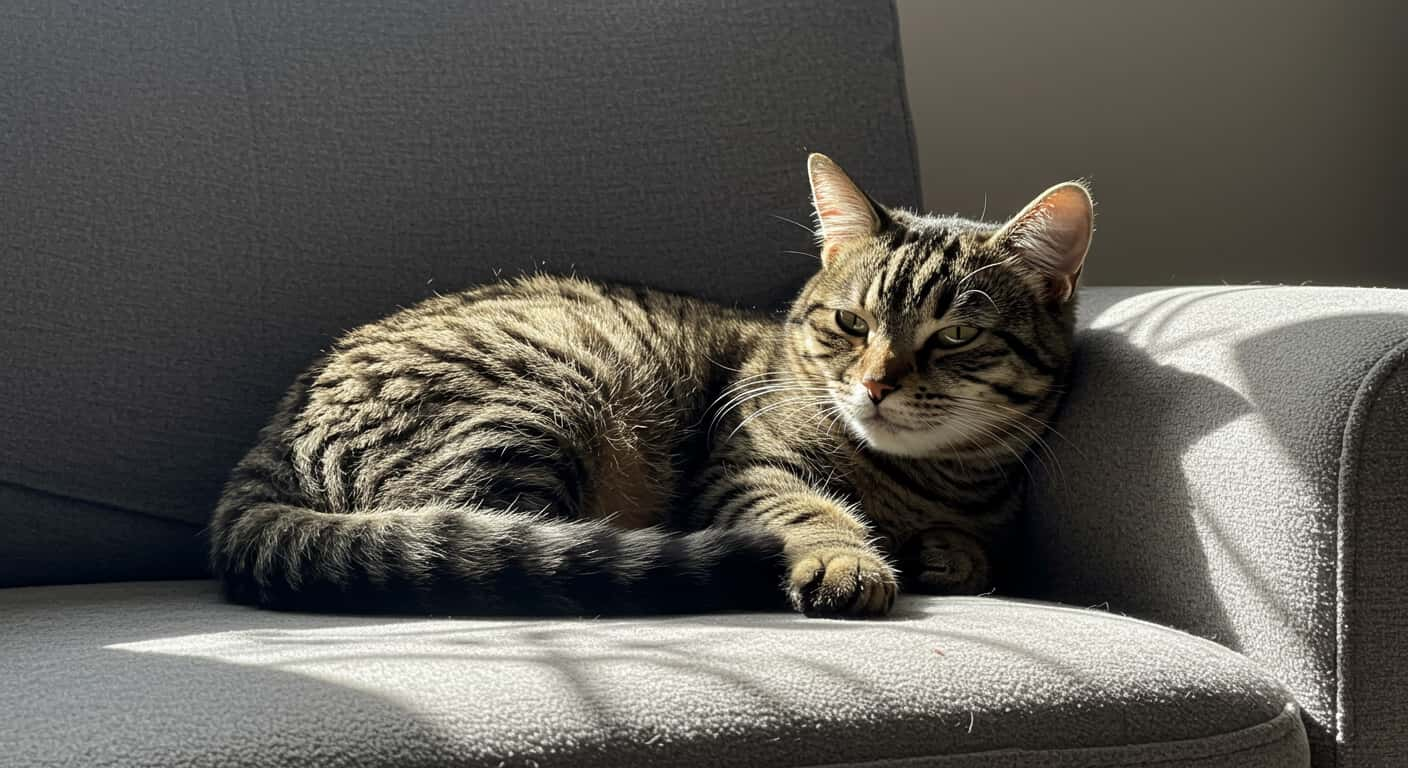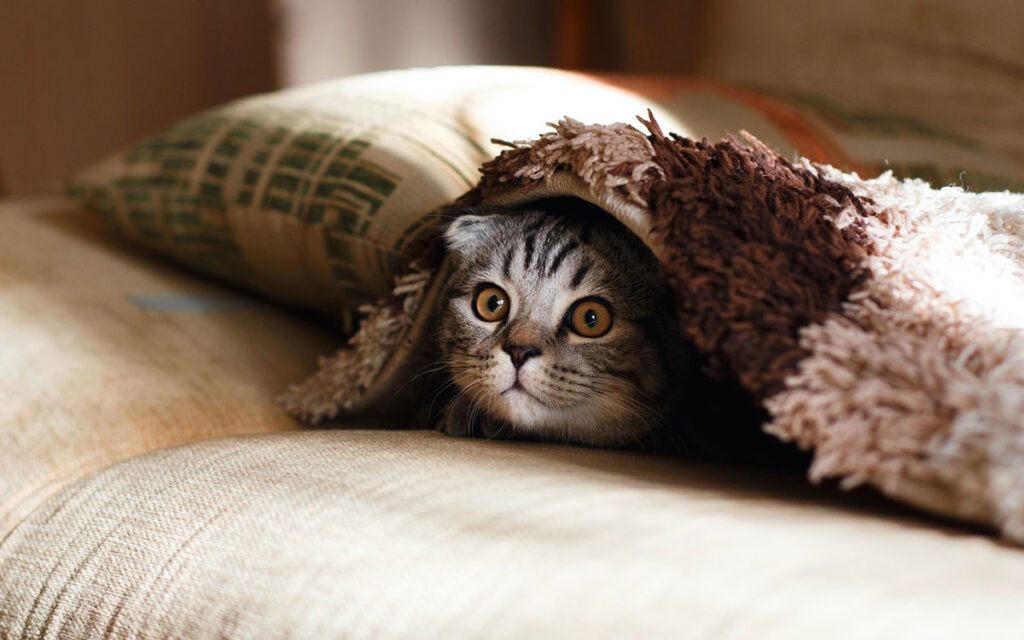Why is tabby cat shedding so much? That’s the question I found myself asking when fur started piling up faster than I could vacuum. A little shedding is normal, it helps regulate body temperature and refreshes your cat’s coat. But when it becomes excessive, it can feel alarming.
I noticed it first with Luna, my tabby. Her usually sleek coat turned patchy one spring, and tufts of fur collected around her favorite window spot. It turned out to be a mix of seasonal change and a need for better nutrition, a fixable issue, once I knew what to look for.
In this guide, you’ll learn what normal shedding looks like for tabby cats, what causes it to get out of control, and the steps you can take to manage it, before your home becomes a fur zone.
Table of Contents
Understanding Normal Shedding in Tabby Cats
“My tabby sheds like crazy even in winter. I thought it was just a summer thing.” That’s how Anna, a cat owner from Michigan, described her striped companion’s fur problem in an online forum. She’s not alone. Many pet parents wonder why their cat’s shedding doesn’t follow the seasons. The truth is, when asking why is tabby cat shedding so much, we have to understand what’s considered normal first.
Shedding is a natural, necessary process. Cats shed dead hair to keep their coat healthy and skin breathable. Outdoor cats tend to shed heavily twice a year, spring and fall, aligning with weather changes. But indoor cats often shed all year due to artificial lighting and consistent room temperatures. According to Chuckanut Valley Veterinary Clinic, “Indoor lighting can disrupt the natural hair cycle, leading to prolonged or uneven shedding.”
Tabby cats aren’t a breed but a coat pattern, seen in both short-haired and long-haired cats. Short-haired tabbies, like the American Shorthair, may shed less visibly, while long-haired types like Maine Coons or Norwegian Forest Cats often leave trails behind. Age also plays a role. Older cats may groom less, resulting in more loose fur and potential matting. Luna, my own tabby, started shedding more noticeably after age six, especially around her haunches where she groomed less.
Here’s a quick comparison to help you assess your cat’s shedding:
| Shedding Type | Normal Signs | Possible Concern |
|---|---|---|
| Seasonal | Even coat loss, no bald spots | Slight increase in spring/fall |
| Indoor Year-Round | Light shedding daily | Changes with lighting or heating |
| Abnormal | Bald patches, red skin, greasy fur | May signal allergy, stress, or illness |
If your tabby’s shedding is symmetrical and their skin looks healthy, it’s likely part of their natural rhythm. However, if you notice patches, flakes, irritation, or your cat stops grooming, it’s time to dig deeper.
As Dr. Julie Bell from Total Vet says, “The pattern of shedding tells us more than the amount. Sudden or uneven fur loss deserves a second look.”
What does normal tabby shedding look like?
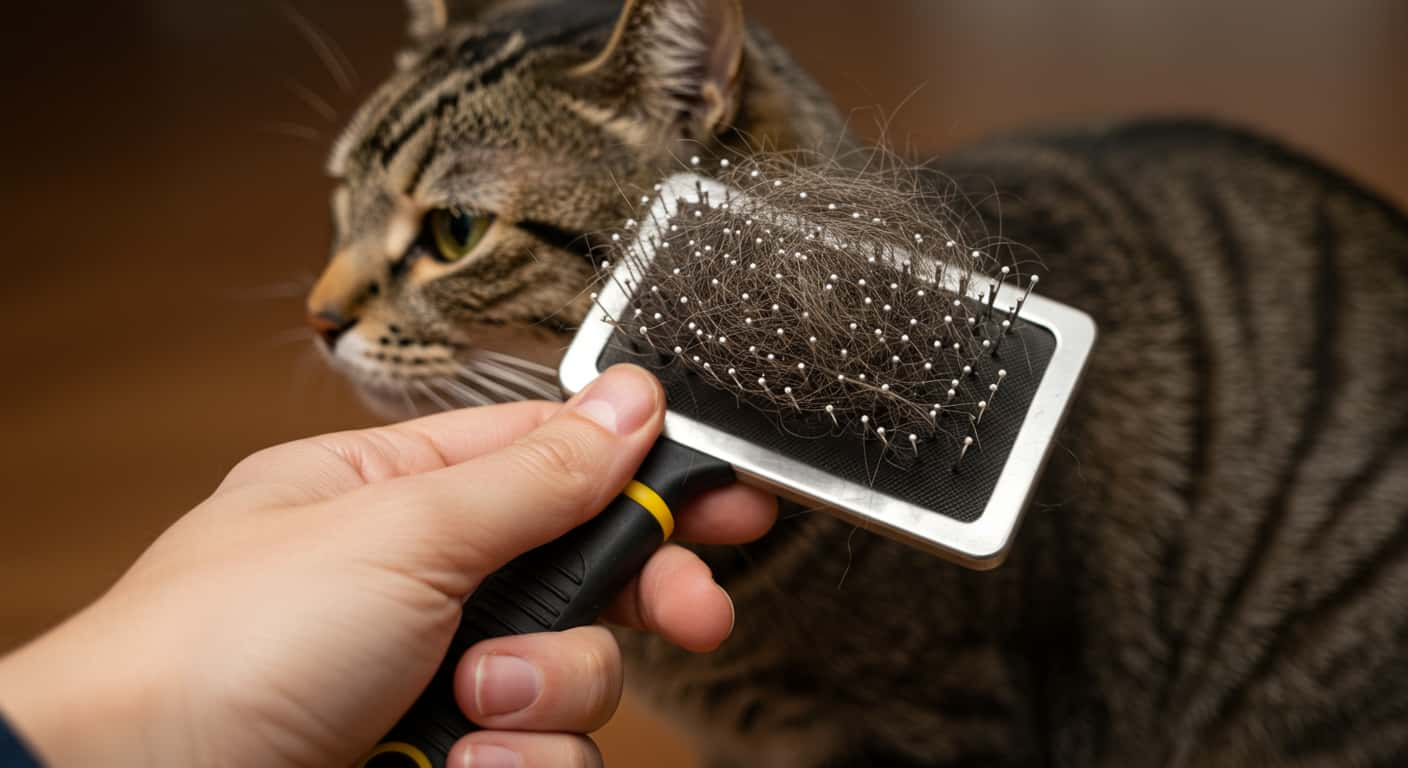
Normal shedding in tabby cats is usually gradual, evenly spread, and doesn’t expose the skin. You may notice it more during brushing or when petting. If your cat still plays, grooms, and eats normally, chances are the shedding isn’t a sign of illness.
If you’re searching for answers to why is tabby cat shedding so much, you’re likely dealing with more than just a seasonal fur swap. Shedding becomes excessive when something in your cat’s body or environment is out of balance.
Common Causes of Excessive Shedding
Joel, a tabby owner from Austin, remembers the moment it clicked. “I thought it was just spring, but the shedding didn’t stop.
Her food didn’t have omega-3s, and she was stressed from a new puppy. Once I fixed that, her coat came back.” His story is a reminder that shedding often speaks for what your cat can’t.
Veterinarians agree that shedding is a surface signal, not a standalone problem. According to Coventry Vet Clinic, “Excessive fur loss is often linked to internal causes like stress, poor nutrition, or parasites, not just weather.”
Use the table below to assess what might be behind your cat’s constant hair loss.
| Cause | Description | What You’ll Notice |
|---|---|---|
| Poor Nutrition | Deficiencies in protein, omega-3, or hydration | Dull fur, flaky skin, hair clumps, slow regrowth |
| Stress and Environmental Change | New pets, moving homes, loud noises | Overgrooming, hiding, fur loss in common grooming zones |
| Allergies (Food or Airborne) | Reactions to food, dust, pollen, or cleaning agents | Scratching, licking paws, thinning around ears or belly |
| Parasites (Fleas, Mites) | Skin irritation from fleas, mites, lice | Itching, red spots, flea dirt, patchy fur loss |
| Skin Infections or Fungus | Ringworm, bacterial dermatitis, yeast | Circular bald spots, scabs, musty odor, crusty skin |
| Hormonal Imbalances | Conditions like hyperthyroidism or adrenal disorders | Oily fur, weight changes, increased appetite, restless behavior |
| Aging and Grooming Issues | Older cats may struggle to groom properly due to arthritis or dental pain | Matted fur, uneven shedding, build-up in hard-to-reach areas |
Not all causes look dramatic at first. Sometimes, the answer to why is tabby cat shedding so much hides in routine details, a new detergent, a forgotten flea dose, or simply aging joints that make grooming harder.
Chuckanut Valley Vet Clinic recommends keeping a weekly fur journal if shedding seems out of control.
“Note the areas where fur is thinning, the texture of the coat, and any behavioral changes. Patterns help us pinpoint the source quickly,” says Dr. Naomi Chase.
Can anxiety cause excessive shedding in tabby cats?
Yes. Stress causes physiological changes that interrupt the normal hair cycle. Cats may shed more during moves, vet visits, or changes in their daily environment. Offering safe spaces, consistent routines, and calming aids like pheromone diffusers can ease the stress and the shedding.
When to Be Concerned About Your Cat’s Shedding
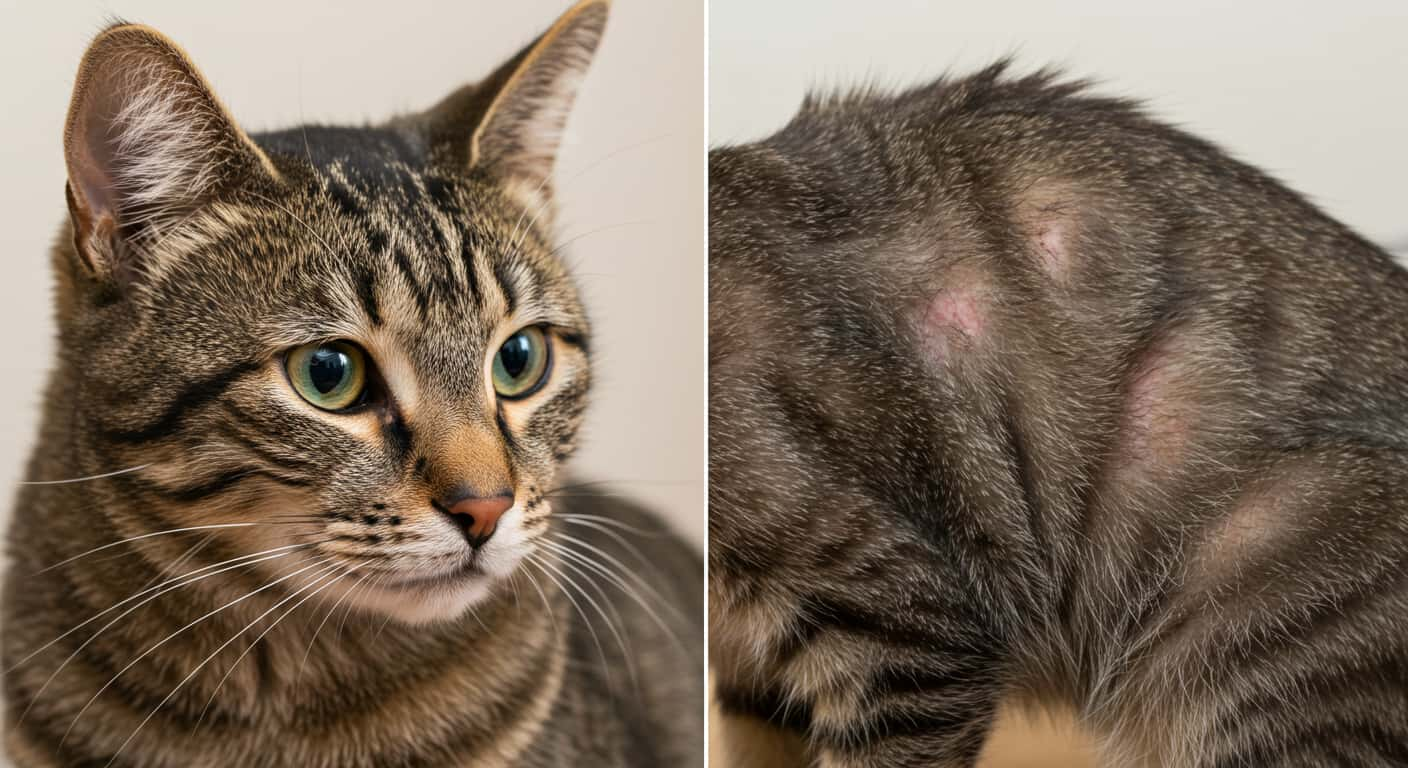
It’s one thing to vacuum daily or pull fur off your sweater. But when should that shedding become a red flag? Many owners only ask why is tabby cat shedding so much after noticing bald spots or irritated skin. At that point, it may be more than routine grooming fallout.
Understand the health issues that may be behind your cat’s hair loss.
Luna, my tabby, once started losing fur around her tail in clumps. At first, I assumed it was seasonal. But when I noticed she wasn’t grooming her back and the skin felt oily, I booked a vet visit. The culprit? A mild fungal infection combined with stress from a noisy renovation. It was a reminder that even subtle behavior changes matter.
Chuckanut Valley Vet Clinic emphasizes that patterns matter more than volume. “Consistent fur loss across the body is less alarming than localized bald spots or greasy fur. These are signs of medical concerns,” explains Dr. Naomi Chase.
Use this table to help determine when to call the vet.
| Sign | What It Might Mean | Recommended Action |
|---|---|---|
| Bald patches | Fungal infection, parasite reaction, self-grooming trauma | Schedule vet visit, rule out infections |
| Red or flaky skin | Allergies, dermatitis, ringworm | Start skin-friendly diet, topical treatment |
| Greasy, sticky fur | Hormonal imbalance, thyroid problems | Blood work, medical treatment |
| Strong odor | Yeast or bacterial infection | Immediate exam, antifungal or antibiotic |
| Excessive licking or biting | Anxiety, fleas, hotspots | Behavior review, flea treatment |
| Sudden shedding spike | Stress or environmental shift | Evaluate household changes |
| Decreased grooming in seniors | Arthritis, dental pain, fatigue | Pain relief, gentle grooming support |
Still asking yourself why is tabby cat shedding so much, even after brushing daily and feeding well? Then pay attention to what else is changing. Are they hiding more? Eating less? Sleeping differently? These small shifts often reveal the bigger issue.
The Total Vet team recommends using the “Three-Day Rule.” If abnormal shedding persists for more than 72 hours, especially with skin symptoms or behavior changes, book a vet appointment. Waiting too long could let something small become serious.
When does shedding mean something’s wrong?
If your tabby cat is shedding unevenly, showing irritated skin, or avoiding grooming altogether, it’s time to dig deeper. Healthy cats shed, but they don’t leave bald spots, oily patches, or strong odors. These symptoms are often linked to allergies, parasites, or medical disorders that need attention.
Solutions and Prevention Tips
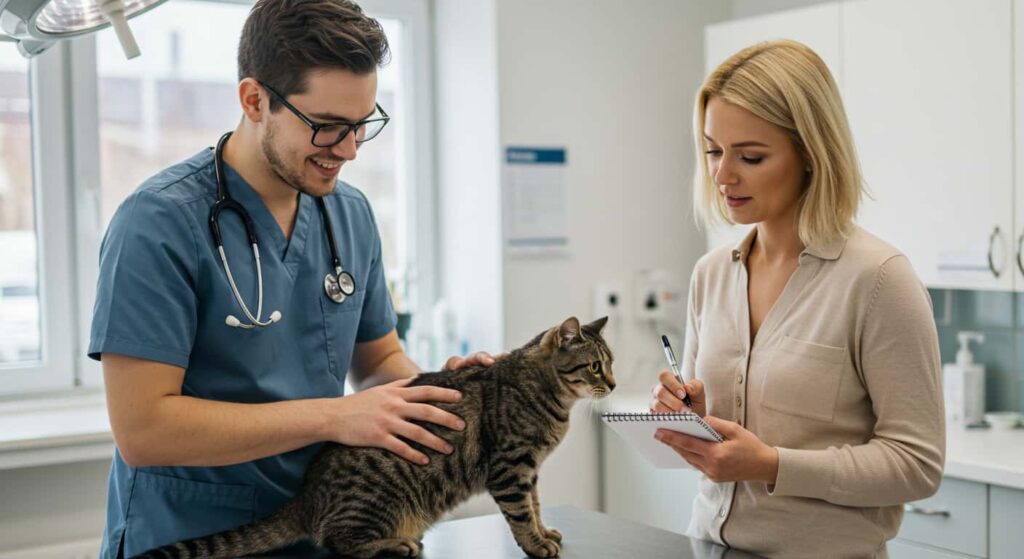
If you’ve been wondering why is tabby cat shedding so much, you’re not alone, but you’re also not helpless. Whether the culprit is diet, stress, or grooming gaps, there are real, practical ways to reduce shedding and bring your cat’s coat back to balance.
Learn how to groom your tabby cat effectively to reduce shedding.
Start by looking at what you can control: food, environment, and habits. Most shedding issues can be managed or improved once you identify the source.
Luna used to shed in tufts every spring, and for a while, I blamed the season. But once I upgraded her kibble and added omega-3 supplements, I saw a visible difference. Grooming became easier, and the fur on my black sofa? Finally manageable.
Use the chart below to map solutions based on the most common causes.
| Problem Area | Recommended Fix | Results to Expect |
|---|---|---|
| Poor Diet | Feed high-protein, omega-3-rich food | Healthier skin, shinier coat, reduced shedding |
| Stress | Add hiding spots, calming pheromone diffusers, maintain a routine | Less overgrooming, smoother fur cycle |
| Allergies | Eliminate triggers (dust, scents), switch to limited-ingredient food | Fewer hot spots, calmer skin, balanced shedding |
| Parasites | Use monthly flea treatments, clean bedding regularly | Stops scratching, fur regrows evenly |
| Grooming Neglect | Brush with de-shedding tools 2-3 times a week, focus on friction zones | Reduced loose hair, less matting, less vacuuming |
| Medical Triggers | Schedule regular checkups, ask for bloodwork if fur texture changes | Early detection of thyroid, liver, or hormone issues |
Grooming Tips That Work for Tabbies
Routine grooming is your best defense if you’re still asking why is tabby cat shedding so much despite a good diet and vet visits. Choose the right brush based on your tabby’s coat length. Short-haired cats do well with rubber curry combs or slicker brushes. For long-haired tabbies, try metal combs and undercoat rakes.
Check out the best brushes for controlling your tabby’s shedding.
Brush gently but thoroughly in areas like the back legs, belly, and base of the tail. These spots tend to hold the most dead fur. Aim for two to three sessions per week, and more during seasonal shifts. Always follow brushing with praise, a treat, or cuddle time to create positive reinforcement.
Environmental Upgrades
Indoor air quality can also influence shedding. Dry winter heat or dusty vents can irritate skin and speed up hair loss. A humidifier near your cat’s favorite sleeping area can help retain skin moisture. Place their bed away from heaters, and offer textured mats or blankets that help collect loose fur without sticking to it.
If you’re still unsure why is tabby cat shedding so much, keep a journal. Track food changes, vet visits, household stressors, and weather conditions. This helps identify patterns and makes future vet consults far more useful.
Should I be using supplements?
In many cases, yes. Omega-3 supplements, especially ones with EPA and DHA, support skin barrier function and hair follicle health. Look for vet-approved liquids or capsules made specifically for cats. But always consult your veterinarian before starting a supplement routine.
Frequently Asked Questions (FAQ)
Why is tabby cat shedding so much compared to other cats?
Tabby cats aren’t a separate breed but a coat pattern found across many breeds, some of which shed more than others. If your tabby has medium or long fur, or belongs to a double-coated breed, that might explain the heavier shedding. But if you’re still wondering why is tabby cat shedding so much even with grooming, look at factors like stress, nutrition, and health conditions.
Can shedding ever be completely stopped?
No. Shedding is part of a cat’s natural skin renewal cycle. While you can reduce the amount with better food, regular brushing, and climate control, cats will always shed to some degree. The goal isn’t to stop it but to manage it so it doesn’t disrupt your home or signal an underlying issue.
What are the best grooming tools for tabby cats?
For short-haired tabbies, a slicker brush or grooming mitt usually works well. Long-haired tabbies benefit from undercoat rakes and wide-tooth combs. Always choose tools based on coat type, and groom gently to avoid irritating the skin.
How can I tell if my tabby’s shedding is still normal?
Shedding is normal if it’s even, slow, and not causing bald spots or irritated skin. If your tabby still grooms, eats, and plays normally, shedding likely isn’t a concern. But if you’re asking why is tabby cat shedding so much while also noticing behavioral or coat texture changes, it’s best to talk to your vet.
Should I worry if my tabby sheds more in certain seasons?
Not necessarily. Most cats shed more in spring and fall, but indoor cats may shed all year due to artificial light and constant temperatures. If the shedding seems extreme or is paired with skin symptoms, that’s when it’s worth digging deeper.
Shedding Isn’t Always a Problem – But It Can Be a Signal
If you’ve made it this far, chances are you’ve spent more than a few mornings lint-rolling your clothes and asking yourself, why is tabby cat shedding so much? Maybe you’ve ruled out the obvious stuff like seasons or diet. Or maybe you’re just now starting to connect the dots between stress, food, environment, and that never-ending fur tumbleweed in your hallway.
What Luna Taught Me About Paying Attention
Luna reminded me that shedding isn’t just about fur. Sometimes it’s a message. When I finally stopped brushing and started asking why is tabby cat shedding so much with real curiosity, I found answers that had nothing to do with the seasons and everything to do with her needs.
One Step at a Time Makes a Difference
If you’re still unsure why is tabby cat shedding so much in your home, take a breath and start small. Adjust the diet. Brush more often. Create quiet spaces. Track what changes. And most of all, don’t be afraid to ask for help. Your vet isn’t just for emergencies, they’re your teammate in all things fur-related.
Explore the most common skin issues that may cause excessive shedding.
You’re Not Alone – Let’s Talk
Have a question? A story? Or just want to vent about finding cat hair in your coffee? Leave a comment below. This space was built for people like you, curious, caring, and maybe just a little fur-covered. You’re not alone here. Not in the shedding, the worrying, or the deep love we all share for our four-pawed roommates.
Veterinary Insight
According to the Cornell University College of Veterinary Medicine, “While shedding is a normal part of a healthy cat’s life, sudden or excessive hair loss can indicate underlying issues such as poor nutrition, stress, or medical conditions. Regular grooming, a balanced diet, and veterinary checkups are key to maintaining coat health.”
Source: Cornell Vet College

